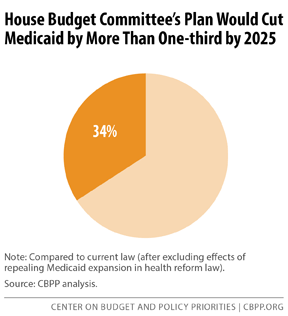BEYOND THE NUMBERS
The House Budget Committee’s budget plan, which the House will consider on the floor this week, states that “Medicaid’s promises are empty,” claiming that beneficiaries don’t have health care providers who will see them and thus don’t have access to needed care.
That’s not true; research shows that Medicaid beneficiaries have access to care comparable to that of private insurance. In fact, it’s the House budget plan that offers the empty promises to the tens of millions of people who rely on Medicaid. The plan’s proposal to block-grant Medicaid and cut federal Medicaid funding deeply will harm millions of low-income children and families, people with disabilities, and seniors by forcing states to cut eligibility, benefits, and provider payments. That will add millions to the ranks of uninsured or underinsured, and take away their access to needed treatments and services. (That’s not even counting the effect of repealing health reform’s Medicaid expansion.)
The House Budget Committee plan says that states will be given “flexibility” to make more choices about their Medicaid programs to best suit their needs. But with a federal funding cut of $913 billion over the next decade — and the cut exceeding one-third by the tenth year relative to current law (see chart) — states’ only choices will be deciding what cuts to make.
For example:
- How much will they lower or eliminate eligibility for low-income parents? (These cuts will adversely affect children covered by Medicaid as research shows that covering parents helps ensure that their children receive care);
- How deeply will they cut payments to pediatricians, and how much will that limit access to care for children on Medicaid?
- Can they continue to provide personal care services that help people with disabilities get ready for work?
- Can they continue to provide any targeted care coordination services to beneficiaries with chronic conditions, which improve recipients’ health outcomes and save states money in the long-term?
- If they cut payments to nursing homes, how much will the quality of care provided to seniors with long-term care needs fall?
The House Budget Committee’s plan offers “flexibility,” but in reality it promises to pass the buck, forcing states to make draconian cuts targeted on their most vulnerable residents.

